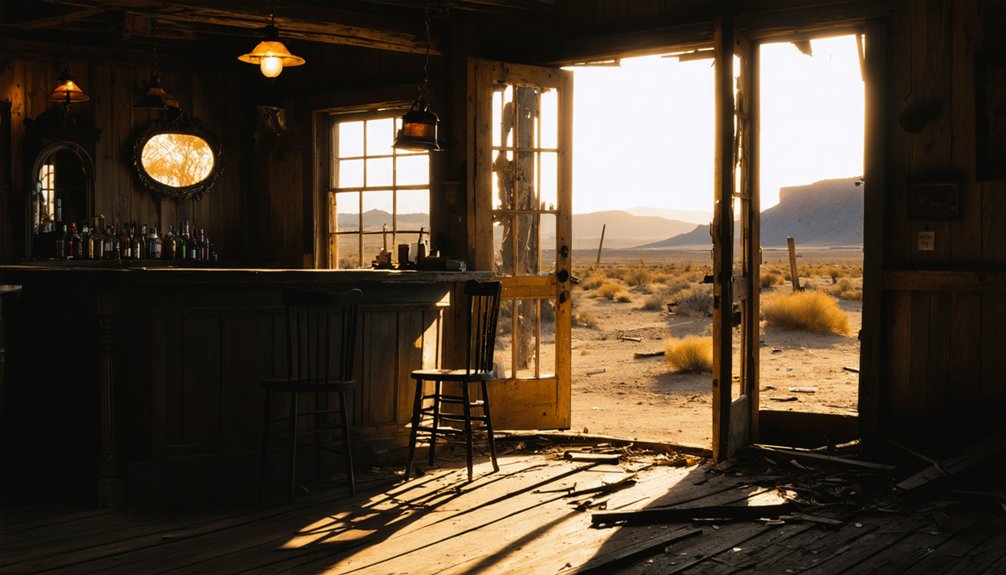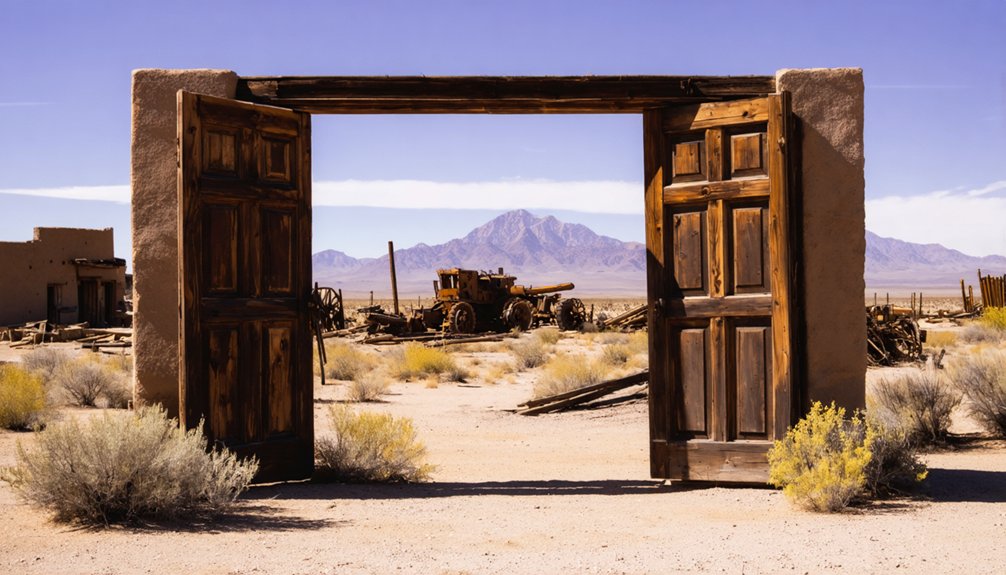You’ll find little remains of Contention City, an 1880s silver boomtown along Arizona’s San Pedro River. Named for mining disputes, this once-thriving settlement processed Tombstone’s silver ore and served as an essential transportation hub. Doc Holliday sought refuge here after the O.K. Corral gunfight, and Sheriff Slaughter battled outlaws nearby. Today, only scattered adobe ruins and foundations mark where flooding and depleted silver ended this classic boom-and-bust frontier story.
Key Takeaways
- Contention City emerged after an 1877 silver discovery and thrived as a mining town until its decline in the 1890s.
- The town functioned as both an ore processing center and transportation hub with railroad connections established in 1882.
- Doc Holliday sought refuge here after the O.K. Corral gunfight, adding to its Wild West historical significance.
- Economic collapse followed when silver prices fell and mines flooded, causing the town’s complete abandonment.
- Today, only scattered adobe walls, stone foundations, and a small cemetery remain within the San Pedro Riparian Conservation Area.
From Mining Claim to Boomtown: The Birth of Contention City
While silver strikes in Arizona Territory weren’t uncommon in the late 1870s, the discovery that birthed Contention City unfolded through a fortuitous accident. In 1877, prospectors Ed Williams and Jack Friday watched as their mules’ dragging chain scraped away dirt, revealing a rich silver vein that would transform the region.
This silver discovery quickly led to the establishment of significant mining operations, but not without controversy. Ed Schieffelin staked his claim to the area, igniting one of the territory’s notable mining disputes.
When the claim was eventually split, Schieffelin named his portion the “Contention Mine” – a fitting tribute to the argument. By 1879, a strategic settlement emerged on the San Pedro River’s east bank, providing the water Tombstone’s mines desperately needed for processing their silver. The town’s first post office opened on April 6, 1880, marking its official establishment. The town grew rapidly, reaching an elevation of 3,799 feet above sea level in the rugged landscape of Cochise County.
Mills and Industry: The Industrial Heart of Tombstone’s Silver Rush
Though Tombstone itself claimed fame as the heart of Arizona’s silver boom, it was Contention City and other riverside settlements that served as the true industrial engines of this mining phenomenon.
These towns along the San Pedro River hosted vital ore processing operations, situated 6-10 miles from the mines to access the water that Tombstone lacked.
Transportation of rich silver-lead ore cost miners $3.50-$5.00 per ton, yet remained essential to the region’s prosperity. The stamp mills crushed high-grade ore, transforming raw rock into valuable silver. The region also benefited economically from the famous Tombstone district which produced approximately 32 million troy ounces of silver during its heyday.
The rumble of stamp mills echoed across the valley as ore became fortune—a costly but necessary industrial pilgrimage.
The district’s production was historically remarkable, with a documented silver to gold ratio of 126 to 1 between 1877 and 1937.
As mines deepened, industrial challenges mounted—particularly water management. By the late 1880s, Cornish pumps removed 2.5 million gallons daily from flooded shafts, an unsustainable expense that ultimately doomed operations when combined with falling silver prices.
These riverside mill towns, now ghostly remnants, reveal the complex industrial backbone that sustained Arizona’s legendary silver district.
Rails, Stagecoaches, and Trade: A Transportation Hub on the San Pedro
Located at a critical juncture along the San Pedro River, Contention City emerged as an essential transportation nexus during Arizona’s silver boom of the 1880s.
When the railroad depot opened in 1882, connecting to the New Mexico and Arizona Railroad network, it transformed the town’s economic prospects. You’d have witnessed fierce stagecoach competition as companies slashed fares and optimized routes to maintain relevance against the railroad’s significance. The intense rivalry between stage line operators H.C. Walker, Billy Ohnesorgen, and J.D. Kinnear even led to incidents of sabotage and poisoning among competing companies. The railroad faced frequent washouts due to its proximity to the river, requiring constant repairs to maintain service.
Contention City’s strategic position between two major stamp mills made it ideal for processing Tombstone’s silver ore. The town served as a scheduled stop on two stage lines while simultaneously functioning as a rail shipping point.
This dual transportation advantage—where stagecoaches and locomotives briefly coexisted—established Contention City as a crucial trade center before newer transportation patterns ultimately contributed to its decline.
Notorious Encounters: Outlaws, Lawmen, and Wild West Legends
When you explore Contention City’s history, you’ll find Doc Holliday sought refuge here after the O.K. Corral gunfight, evading prosecution while cementing the town’s place in Wild West lore.
The settlement witnessed Sheriff John Slaughter‘s dramatic 1886 confrontation with the Jack Taylor Gang, a bloody shootout that left multiple outlaws dead and Slaughter wounded but victorious.
These violent encounters transformed this transportation hub into a legendary frontier flashpoint where the thin line between lawmen and outlaws often blurred in Cochise County’s notoriously lawless landscape. The area’s reputation for violence was further solidified during the Apache Wars period, when raids and skirmishes between settlers and Native Americans were commonplace.
Doc Holliday’s Hideout
Among the most infamous figures to traverse Contention City’s dusty streets, Doc Holliday stands out as both a legendary gunslinger and a reluctant participant in the town’s legal drama.
Holliday’s legacy intertwines with Contention’s conflicts through strategic movements rather than permanent residency.
When visiting this ghost town, you’ll appreciate how it served Doc Holliday in four significant ways:
- As a legal refuge when Ike Clanton pursued charges after the O.K. Corral shootout
- As a transportation hub when escorting wounded Virgil Earp in 1882
- As a strategic location within the lawmen-outlaw network of the Arizona Territory
- As a temporary haven alongside Wyatt Earp during their vendetta ride
Though no trial materialized here, Contention City remains an essential waypoint in understanding Holliday’s complex navigation of frontier justice and survival.
Slaughter’s Final Showdown
While Doc Holliday‘s presence in Contention City left its mark through legal maneuvers, Sheriff John Slaughter‘s deadly confrontation with the Jack Taylor Gang cemented the town’s place in Wild West folklore.
In 1886-1887, Slaughter’s tactics reflected the urgency demanded by the gang’s cruelty. After tracking the notorious outlaws to Guadeloupe Robles’ home, Slaughter led a raid without warning. The ensuing gunfight turned bloody quickly—Nieves Deron’s shot clipped Slaughter’s ear before the sheriff delivered a fatal return. Slaughter kept his pearl-handled .44 ready throughout the dangerous confrontation. The Arizona lawman was widely respected by peers including legendary figures like Wyatt Earp for his determined pursuit of justice.
Manuel Robles escaped wounded but later met his end in Mexico’s Sierra Madre mountains.
The showdown’s aftermath scattered the remaining gang members—Jack Taylor imprisoned for life, Geronimo Miranda killed by Mexican police, and Fred Federico captured after a fatal mistake.
The Inevitable Bust: How Silver’s Decline Emptied a Town

As the 1880s drew to a close, Contention City’s fate became inextricably linked to the silver that had given it life.
You’re witnessing the textbook definition of economic collapse – a town that vanished when its single industry failed.
The mining decline manifested through:
- Exhaustion of silver ore reserves by 1890, rendering mill operations unsustainable
- Closure of the Contention and Sunset mills, eliminating jobs for 80 workers
- Loss of transportation relevance as railroads bypassed the settlement for Fairbank
- Devastating mine flooding in 1888 that permanently crippled production
The area had once contributed significantly to Tombstone’s impressive output of 32 million ounces of silver before the decline.
Without silver processing, Contention City lost its purpose.
The silver veins ran dry, and with them, the lifeblood of a town that existed only to transform ore into wealth.
The post office shuttered, businesses abandoned storefronts, and a community once dubbed “The Comstock of Arizona” faded into desert dust.
What Remains Today: Exploring the Ruins of a Desert Ghost Town
Today’s visitor to Contention City will find only ghost-like traces of what was once a bustling silver boomtown. As you explore the ruins, you’ll encounter scattered adobe wall remnants, stone foundations, and cellar holes—deliberately preserved historical markers amid a landscape once bulldozed to prevent squatters.
The most significant remnants cluster around the former milling complexes along the San Pedro River’s east bank. These collapsed stamp mill foundations stand as silent testimony to the industrial hub that once processed silver from nearby Tombstone mines.
Though no intact buildings remain, your ruins exploration reveals the town’s layout through foundation stones marking former saloons, hotels, and commercial establishments.
A small cemetery offers the most poignant connection to former residents, while the surrounding desert slowly reclaims these artifacts despite historical preservation efforts within the San Pedro Riparian Conservation Area.
Frequently Asked Questions
Were Any Movies or TV Shows Filmed in Contention City?
Despite the Netflix of the Old West, no. While Contention City appears as a setting in productions like “3:10 to Yuma,” actual film locations and television productions never utilized its remote, deteriorated ruins.
What Happened to the Residents After the Town Was Abandoned?
You’ll find town history reveals residents scattered to nearby Tombstone and Tucson, seeking mining opportunities or agricultural work. Some resident stories continued elsewhere in Arizona as economic necessities drove their westward migration.
Are There Any Haunting Legends Associated With Contention City?
Despite diligent documentation, you’ll find no firmly established folklore tales or ghost sightings associated with Contention City. Historical records reveal no paranormal accounts despite the town’s violent past and abandoned structures.
Can Tourists Visit Contention City Today Without Special Permits?
Yes, you can visit without permits. While no formal ghost tours exist, tourist access remains unrestricted. You’ll need to hike or bike the eight-mile round trip from nearby Fairbank.
Did Any Famous People Besides Outlaws and Lawmen Live There?
You won’t find famous non-outlaw/lawman residents in historical records. John McDermott and Col. Rigg had local significance as a businessman and justice, but lacked broader historical fame beyond Contention City’s borders.
References
- https://kids.kiddle.co/Contention_City
- https://westernmininghistory.com/towns/arizona/contention-city/
- https://www.abandonedspaces.com/towns/contention-city.html
- https://rareingot.com/contention-mine/
- https://www.quarterly-review.org/contention-city/
- https://www.wyattearpexplorers.com/contention-city-and-its-mills.html
- https://www.desertlavender.com/southern-arizona/dragoons/contention-city.php
- https://turtledove.fandom.com/wiki/Contention_City
- https://goodenoughsilvermine.com/pages/about.html
- https://www.truewestmagazine.com/article/tombstones-competitor/



